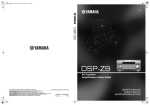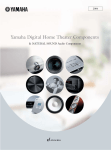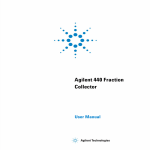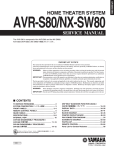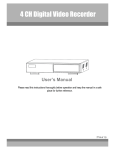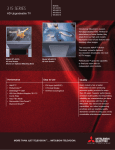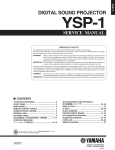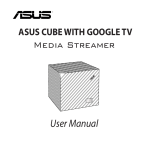Download Yamaha DSP-Z9 Specifications
Transcript
DSPZ9 R_Catalog_H1_H4.qxd 03.11.10 6:43 PM ページ H1 DSP-Z9 Digital Home Theater Amplifier Extraordinary capabilities for the finest home theater performance DSPZ9 R_Catalog_P02_03.qxd 03.11.10 6:47 PM ページ 2 Only Yamaha could set these goals — and achieve them! The DSP-Z9 was developed to achieve four ambitious goals: deliver the highest sound quality, provide the highest picture quality, present the best surround realism and be the easiest amplifier to use. We believe we succeeded in all four areas, but we invite you to judge for yourself — we’re confident that the DSP-Z9 will totally satisfy your highest expectations. DSPZ9 R_Catalog_P02_03.qxd 03.11.10 6:47 PM ページ 3 Highest Sound Quality The DSP-Z9 offers the industry’s most advanced audio technology, circuitry and component parts, backed by over a century of experience and an undiminished commitment to “natural sound.” Highest Picture Quality As the central control unit in a home theater system, the DSP-Z9 interfaces with video source and display components to ensure that video performance is on a par with the sound quality. Best Surround Realism Yamaha developed its audio and cinema digital sound field processing technology decades ago and has been refining it ever since. The DSP-Z9 offers an unrivaled, breathtaking surround sound experience. Easiest to Use Yamaha amplifiers have a long history of introducing features that enhance operating ease. The DSP-Z9 continues this tradition with one major convenience breakthrough and many other advanced features. DSPZ9 R_Catalog_P04_05.qxd 03.11.10 7:23 PM ページ 4 Highest Sound Quality Yamaha has a genuine commitment to providing absolutely the finest sound quality possible in every component we create. With over a century of experience in sound production (we made our first reed organ in 1887) and our status as a world leader in acoustic and electronic musical instruments, we are passionate about creating and reproducing sound in the most beautiful and natural way. Over the years, with each new series of components, we have improved and refined audio performance, and the DSP-Z9 maintains this tradition with an impressive array of technology and features. High Performance Digital Circuit High-Definition CINEMA DSP Circuit Direct Stereo SEL DIR Digital Input Decoder Multi(8)Channel Input 96 kHz/ 24-Bit ADC Minimal Analog Processing Selector i.LINK High Current Amplification CINEMA DSP and HiFi DSP (YSS-930 x 4) YPAO (Yamaha Parametric Room Acoustic Optimizer) (YSS-930 x 4) SEL DAC VOL • Front L • Front R SEL DAC VOL • Center SEL DAC VOL • Surround L • Surround R SEL DAC VOL • Surround Back L • Surround Back R DAC VOL • Presence L • Presence R DAC VOL • Subwoofer L • Subwoofer R SEL 192 kHz/24-Bit DAC for 11 Channels Accurate—Touch Volume Control (-80—+16.5dB) YAC-520 LSIs for 11 Channels Digital ToP-ART Design Digital ToP-ART (Total Purity Audio Reproduction Technology) is a Yamaha product development philosophy that combines advanced digital engineering and circuit design to maximize audio signal purity. It is used in three sections of the amplfier, the High Performance Digital Circuitry and High Current Amplification (explained right) and the High Definition CINEMA DSP circuitry (explained on page 10), each of which employs the world’s highest grade parts and most sophisticated LSIs. Digital ToP-ART enables the DSP-Z9 to deliver superb sound quality and bring out the full potential of Yamaha’s amazing CINEMA DSP technology. 4 High Performance Digital Circuitry This section exemplifies the Digital ToP-ART (Total Purity Audio Reproduction Technology) concept of maximizing the quality of the digital circuitry while minimizing analog circuitry, and also maintains a straight and logical circuit layout for optimum signal purity. It includes a variety of sophisticated technology, beginning with Burr-Brown 192kHz/24bit digital-to-analog converters for all channels with DSD (Direct Stream Digital) compatibility. Accurate-Touch Volume Control LSIs (Yamaha YAC520) are also used for all channels. The digital bass and treble tone controls have turnover frequencies for the front L/R and center channels. Eight-channel analog input signals are processed by 96kHz A/D conversion for highest quality. All circuitry is on a four-layer processing board in a fully shielded cabinet for reduced digital interference. 9-Channel Amplifier Capable of Delivering 1,890W When you power up your carefully assembled, top class home theater system, you expect beautiful sound and video quality, but you also want plenty of raw power. Especially at dynamic peaks, such as explosions or the climax of rock songs, you want to be thrilled and awed, without a hint of distortion marring the moment. The DSP-Z9 is built to satisfy your urge for power, surrounding you front, sides and rear with seven channels capable of outputting a huge 250 watts each, plus another 70W from the two presence (front effect) channels. That’s a total of 1,890W, which will impress your friends, and even your neighbors if you so choose. Movies will sound as if you’re in the director’s chair, and you can even enjoy multi-channel sources from only four or five speakers (even without a subwoofer, although this is not recommended), thanks to a 6-4 mixdown mode. Another point to consider is that because of this high power capability, at normal listening levels the amplifier won’t be working as hard, so distortion levels are virtually zero. High Current Amplification Although power rating is often the first thing people look at in a amplifier, high power output does not necessarily mean good sound. High current level is a much more important factor, so Yamaha developed the High Current Amplification system, which overcomes two problems common DSPZ9 R_Catalog_P04_05.qxd 03.11.10 7:23 PM ページ 5 to ordinary amplifiers. The first is a difference in voltage between the power supply and amplifier circuits caused by current fluctuations. This was solved by using custom-made, high-grade block electrolytic capacitors and a copper grip for onepoint grounding. Another current drop is generally seen between the amplifier circuit and the speaker terminals, caused by the cables, speaker output relays, copper circuit boards, and so on. To avoid this problem, we used an extralarge, low-impedance toroidal transformer and gold-plated speaker relay contacts. As a result, the DSP-Z9 achieves low impedance, high current power from input (power supply circuit) to output (speaker terminals). This drives the speakers much more smoothly and dynamically, for better sound from all sources, including 2-channel audio. Choice of Signal Paths for Optimum Quality The DSP-Z9 gives you a choice of specialized signal paths, ensuring that you can obtain the purest signal quality possible. Pure Direct provides the shortest possible signal path for two-channel or multi-channel analog inputs, with no signal processing and no display. Straight DSP-Z9 Front Channel Signal Flow Differences between three front specialized signal paths + Pure Direct (2 Channels, L/R) Pure YAC-520 Direct (2ch) Volume Control Pure Direct (Multi-channel, L/R) Preout Multi-Channel In Analog L/R Analog/DSP Input Selector DSP outputs the original analog or digital signal without any post-processing. i.LINK provides a digital connection for DVD-Audio Linear PCM, Super Audio CD DSD (Direct Stream Digital) and other high quality audio sources. And Direct provides a direct connection for analog stereo/multichannel input and digital stereo/multichannel (via i.LINK) input, with a dimmed display. Pure Direct Straight Direct Selection Front Panel & Remote Front Panel & Remote Program Sources 2-Ch Analog (Direct Input)/ Multi-Ch Analog Analog & Digital Analog & Digital (PCM/DSD) A/D Conversion — Yes No Decoding — Yes No Post-processing — No No (Bypass) High-Sound Quality, High Reliable Gold-Plated Relays YPAO Spkr. Config. — Yes No (Bypass) YPAO Tone Control — Yes No Balanced Signal Transmission for Lower Noise and Distortion. YPAO Spkr. Level No Yes No Display Off Yes Dimmed DSP-Z9 Digital Home Theater Amplifier 5 DSPZ9 R_Catalog_P06_07.qxd 03.11.10 6:50 PM ページ 6 Symmetrical Power Amplifier Circuitry The High Current Amplification system uses a symmetrical, full push-pull circuit configuration with a complementary FET input stage. This ensures balanced output with no signal interference and highest slew rate (rate at which signal changes; affects high frequency response). Furthermore, the massive toroidal transformer and large capacity block electrolytic capacitors (28,000µF) ensure a consistently stable power supply. Symmetrical Power Amplifier Circuit Block Diagram In + NFB Bias Circuit +B Speaker Out -B 9-Band Graphic Equalizer In addition to the many audio parameters that can be adjusted via the on-screen menus, the DSP-Z9 gives you an even greater degree of sound field control with the inclusion of a 9band graphic equalizer. You can use it to “fine tune” the sound field to achieve the optimal imaging for movie sound. Digital Tone Controls The front left, front right and center channels have digital tone controls, allowing an extremely precise degree of control over the front sound field. Subwoofer Crossover Selection The DSP-Z9 provides a choice of nine subwoofer crossover frequencies: 40, 60, 80, 90, 100, 110, 120, 160 and 200 Hz. In addition to providing a wider range than other amplifiers, the steps from 80 to 120 Hz are only 10 Hz apart for more precise selection. This choice of crossovers lets you “fine-tune” the audio system by selecting the optimum frequency to maximize amplifier/speaker efficiency and also ensures best performance from a wider variety of speakers (small to large). 6 Effective Linear Damping Level variations due to high impedance tend to reduce an amplifier’s damping factor (ability to control unwanted speaker cone movement at low frequencies), and frequency variations cause it to fluctuate. Yamaha’s Linear Damping circuit cancels the effect of these variations, maintaining a high, stable damping factor for superior sound articulation and frequency response. Accurate Touch Volume Control No one expects more from a volume control than up and down — except Yamaha. We decided that controlling the volume could be made both easier and more accurate, and the result is the Accurate Touch Volume Control. It lets you make delicate adjustments within a narrow range, yet enables you to move to very high or low levels more quickly. Its extreme accuracy, with negative gang error of less than 0.5dB, due to a high signal resolution analog design in conjunction with ultraprecise digital control circuits (Yamaha original Accurate Touch YAC-520 LSIs) for all volume control device channels. The wide control (Yamaha YAC-520 LSI) range extends from –80dB to +16.5dB, with narrow 0.5dB steps throughout the entire range for delicate control, even at low volumes. High Grade Construction with Independent Chambers and Anti-Vibration Design The DSP-Z9 uses a heavy-duty, rigid chassis construction with separate chambers for individual chambers for left and right power amplifiers, power supply and control section to prevent any chance of internal interference. This thick chassis also has electromagnetic shielding. The extremely large aluminumextruded heat sinks have anti-resonance characteristics and ensure effective heat dissipation. Supporting all this are Yamaha’s ToP-ART base and feet, which provide stability and further vibration-damping. Gold-Plated-Extruded Gigantic Speaker Terminals Power Amplifier Chambers (L/R) and Power Supply Chamber Preamp Chamber Video Chamber DSP Chamber DSPZ9 R_Catalog_P06_07.qxd 03.11.10 6:50 PM ページ 7 Gold-Plated Extruded, ExtraLarge, Speaker Terminals Two Direct Signal Path Speaker Relays with Gold-Plated Crossover Connection and Shielding Power Amplifier (Right) with Large, Anti-Resonance, Aluminum-Extruded Heat Sink Power Amplifier (Left) with Large, Anti-Resonance, Aluminum-Extruded Heat Sink Power Supply Chamber with Extra-Large Toroidal Transformer and Extra-Large Custom-Made Block Electrolytic Capacitors (28,000µF) Control Section Only the Finest Parts are Used in This Amplifier At this degree of extreme sound quality, each and every part in the amplifier makes a difference. Yamaha technicians tested, selected and in many cases custom-designed all parts, and then tested them in groups to ensure that they sounded good together. Particularly noteworthy parts, in addition to the transformer and capacitors, include: • Schottky Barrier diodes allow fast switching for high S/N ratio. • Thick PC board wiring with 1.6mm diameter copper jumper cables. • Two direct signal path speaker relays with goldplated crossover connections and shielding. • Gold-plated extruded, extra-large speaker terminals. 3 4 5 6 1 2 (1) Large, powerful toroidal transformer (2) Extra-large, custom-made block electrolytic capacitors (28,000µF) (3) Schottky Barrier diodes (4) Gold-plated extruded, extra-large speaker terminals (5) Direct signal path speaker relay (6) High quality selected parts 7 DSPZ9 R_Catalog_P08_09.qxd 03.11.10 7:16 PM ページ 8 Highest Video Quality As one of the first companies to popularize “home theater” and a leader in the field, Yamaha is naturally committed to visual as well as audio excellence. We want our customers’ enjoyment of Digital Video Up and Down Conversion movies and other video sources to be totally satisfying. One way of ensuring the highest video quality for your home theater system is to use the best possible video signal. The DSP-Z9 automatically upgrades the input signal (composite to S-Video or component, S-Video to component) to the one that your monitor/TV can accept. This means that you simply use the best possible cable between the amplifier and the monitor/TV, and then whatever the source is, you are assured of getting the highest possible quality. Our home theater line includes a number of high performance products, including projectors, DVD players and a plasma monitor, but in terms of our home theater components, we design them to deliver the finest possible video signal to the display component. The DSP-Z9 accomplishes this more adroitly than any other amplifier, so you enjoy superb image quality to complement the incredible surround sound. Digital Video Processing Board All digital video processing circuitry is on a single board, housed in its own separate chamber to completely avoid interference from other circuitry. DSP-Z9 Video Circuit Block Diagram Digital Video Up and Down Conversion Component Video Buffer Component Video Decoder with 10bit ADC YAMAHA Component Video Digital Video Processor YGV619 Video Decoder with 10bit ADC S-Video Buffer Composite Video Digital Video Format Converter DCDi Processing & TrueLife Enhancer * Analog Devices Component Video 216MHz Video Encoder with NSV 12bit DAC S-Video S-Video * FLI2310 S-Video 3D Y/C Separator (for NTSC) & Time Base Corrector 16M SDRAM LPF Faroudja Time Base Corrector Component Video Composite Video LPF Composite Video Composite Video 64M SDRAM 64M SDRAM Up video conversion (composite to S-Video and component, S-Video to component) as well as down video conversion (S-video to composite) is automatically applied to incoming signals. * 480i and 576i (PAL) only 8 DSPZ9 R_Catalog_P08_09.qxd 03.11.10 7:16 PM ページ 9 DCDi Processing The DSP-Z9 is the first receiver to offer Faroudja’s DCDi Processing, which is selectable and ensures that images are smooth and natural, without staircasing or jaggies. Faroudja DCDi processing LSI (FLI 2310) Noise Shaped Video™ This technology, from Analog Devices, uses oversampling and advanced techniques such as multi-bit sigma-delta processing and bitshuffling to improve converter performance by moving converter noise to an area of the spectrum where it can be removed by an analog filter. This improves the accuracy of signal representation, allowing images to be displayed at much higher resolutions. Progressive Scan Video Output and Other Video Technologies The DSP-Z9 is the first amplifier to provide Progressive Scan Video Output, for use with high definition monitors. With YGV-619 video almost twice as much video processor LSI data, it provides a sharper, (Yamaha original) noise-fee picture with clearer details. The progressive circuit is an 3:2 Pull-Down Detection type, and gives you the benefit of progressive scanning even if your DVD player does not have it. Other video technologies include 216MHz/12-bit Video D/A Conversion, Motion Adaptive Noise Reduction, Cross Color Suppression, Aspect Ratio Conversion, a Time Base Corrector that prevents the wavy distortion seen in video tapes and TrueLife Enhancer by Faroudja that brings out details in the picture, producing a more life-like image. HDTV (720i/1080i) Compatible Component Video Out The frequency response of the component video monitor out signal is 5Hz–100MHz, making it compatible with HDTV monitors. Image Adjustment To ensure that the high quality image looks precisely the way you want it to, the DSP-Z9 includes an extremely detailed Image Adjustment function. You can select three modes, Cinema, Standard or Dynamic, and within those modes, you can “finetune” five parameters: Enhancer, 3D NR, Brightness, Contrast and Saturation. You can then store your final adjustments in the user memory for recall at any time. Before TrueLife Enhancer (Left) vs. After True Life Enhancer (Right) Without Film Mode (Left) vs. With Film Mode (Right) DCDi Off (Left) vs. DCDi On (Right) Time Base Corrector Off vs. Time Base Corrector On (Right) Above images are simulated. Digital Component Video Up Conversion Circuit Configuration Composite Video Signal S-Video Signal Component Video Signal 3D Y/C Separation Video Decoder & Time Base Corrector DCDi • i/p Conversion • 3:2 Pull Down • TrueLife Enhancer Video Encoder & NSV (Noise Shaped Video) Composite Video Out S-Video Out Component Video Out 9 DSPZ9 R_Catalog_P10_11.qxd 03.11.10 6:53 PM ページ 10 Best Surround Realism Conventional multichannel systems base their sound on Dolby Digital and DTS decoding, using relatively simple matrix and steering techniques to create surround sound effects. Yamaha’s CINEMA DSP Digital technology is much more sophisticated. It naturally decodes the Dolby Digital and DTS movie sound formats, but it also draws on a huge memory of real-world data from actual venues (especially for the music programs) and input from movie sound technicians. This data is stored and processed on Yamaha-developed LSIs, the most powerful audio chips in the world. Our latest technology, Quad-Field CINEMA DSP actually creates four independent sound fields (front, left surround, right surround and surround back) that merge to envelop you in an unmatched surround sound experience. You hear movies and music with accurate sound localization, smooth movement across the sound space, exceptional clarity and remarkably realistic presence. It will seem as if the walls of your room have disappeared and you are in the middle of your own immense theater! Conventional 7.1-Channel Systems High-Definition CINEMA DSP Circuitry The DSP-Z9 has six times greater DSP capacity than previous models, thanks to an increase from 48kHz A/D converters to 96kHz/24-bit types that can accept 96kHz signals for direct digital conversion and processing. Higher density processing enables approximately triple the amount of early reflection data to be handled, for significantly richer surround sound performance. The DSP-Z9 also employs 192kHz/24-bit D/A conversion and DSP processing and Yamaha’s 32-Bit Floating-Point Quantization System LSIs (YSS930 x 4) for high precision decoding of Dolby Pro Logic IIx, Dolby Digital, DTS Digital Surround, DTS 96/24, DTS-ES Discrete 6.1, DTS-ES Matrix 6.1 Yamaha’s Exclusive and DTS Neo:6 formats. There are YSS-930 32-Bit Floating 55 surround programs available, Point Quantization LSI with 79 variations, including Quad-Field CINEMA DSP programs for 6.1-Channel Digital Surround. SILENT CINEMA for surround sound through headphones and Virtual CINEMA DSP for twospeaker systems are also included. Quad-Field CINEMA DSP Presence (Front Line) Sound Field Dialogue Effect Music Surround Right Sound Field Surround Left Sound Field 4-Layer DSP Processing Board in DSP Chamber All of the DSP IC chips and related circuitry are located together on a 4-layer board, which provides a number of advantages. The dimensions are smaller (2/3 previous types), so signal paths are shorter and there is more space for the large power supply components. Digital interference is reduced and impedance is lower as well. Yamaha Uses Actual Sound Field Data Yamaha developed a technique called Single Point Quad Miking to precisely capture the acoustic patterns of sound spaces. This complex data is stored and processed on extremely sophisticated LSIs designed and manufactured by Yamaha. Surround Back Sound Field 10 DSPZ9 R_Catalog_P10_11.qxd 03.11.10 6:53 PM ページ 11 Triple The Density DSP-Z9 Surround Programs 55 Surround Programs (79 Variations) How Sound Propagates (Previous Model) STEREO Stereo Direct HiFi DSP Programs Direct Sound Early Reflections Munich How Sound Propagates (DSP-Z9) Direct Sound Early Reflections Double The Speed Fs: 48kHz Previous 0—22kHz DSP-Z9 0—44kHz 2-Channel Expanding Frequency Response 55 Surround Sound Programs The DSP-Z9 offers a huge range of 55 surround sound programs to choose from, plus another 24 variations of the CINEMA DSP movie programs. For video material, you can select the program that matches your video source, with 12 choices from games and TV sports to Sci-Fi movies. For music, you have 21 choices ranging from European concert halls to disco ambience. Each sound field is created from acoustic data recorded at the actual venues, stored and processed by highly sophisticated Yamaha technology. There are also 16 straight movie format decoding programs and 6 THX programs, including Ultra2*. Naturally, you can experiment with different programs for each source, and you can also use the GUI menus to adjust numerous parameters for each program. With CINEMA DSP, you will never be bored or dissatisfied with the sound of your system!! *THX Ultra2 is a surround program for home use, based on the THX Theater processing developed for movie theater surround sound. Audio Delay for Adjusting Lip-Sync The YSS-930 LSI in the DSP-Z9 provides synchronization of images and sound, which is called lip-sync. The video signal goes through the video processor circuit before it is displayed, which takes time, so it lags behind the audio. The YSS-930 accurately aligns them and even allows the lip-sync parameters to be adjusted using the Audio Delay mode. Fs: 96kHz Double the Signal Capacity Night Listening Mode When you’re listening to movies late at night and turn down the volume during loud scenes, dynamic range suffers and you may miss some dialogue and other sounds. By using the Night Listening Mode, you can reduce the volume and still enjoy proper tonal balance and dynamic range. You hear dialogue clearly and the music and action are just as exciting (without the screams and explosions disturbing others). Enjoy Surround Sound through Headphones SILENT CINEMA makes it possible to hear large-scale surround sound through ordinary headphones! This is a variation of CINEMA DSP technology that Yamaha developed to let you listen in private to movies and other multi-channel sources for hours without listening fatigue. Surround Sound from Only Two Speakers With just two left and right speakers, the Virtual CINEMA DSP mode will create two additional “virtual” rear speakers, giving you the sense of being in a full-scale surround sound field. So even in rooms with no space for rear speakers, you can enjoy the exciting effects of Dolby Digital and DTS movie sound formats. A Frankfurt CONCERT HALL 1 Stuttgart Munich B Vienna Amsterdam Hall G in U.S.A. Hall H in U.S.A. CONCERT HALL 2 Live Concert Tokyo Freiburg CHURCH Royaumont Village Gate Village Vanguard JAZZ CLUB The Bottom Line The Roxy Theatre ROCK CONCERT Warehouse Loft Arena Disco ENTERTAINMENT Party 9-Channel Stereo 9-CH STEREO Program Subtotal 21 CINEMA DSP Programs ENTERTAINMENT Game TV Sports TV THEATER Mono Movie Pop/Rock DJ MUSIC VIDEO Classical/Opera Pavilion Spectacle MOVIE THEATER 1 Sci-Fi Adventure MOVIE THEATER 2 General ENHANCED Enhanced Program Subtotal 12 Decoder Straight Programs Dolby Digital Dolby Digital/ EX DTS Digital Surround DTS 96/24 DTS-ES Matrix 6.1 DTS 96/24 ES (6.1) DTS-ES Discrete 6.1 Dolby Pro Logic Dolby Pro Logic II Music Dolby Pro Logic II Movie Dolby Pro Logic II Game Dolby Pro Logic IIx Music Dolby Pro Logic IIx Movie Dolby Pro Logic IIx Game DTS Neo:6 Music DTS Neo:6 Cinema Program Subtotal 16 THX Programs Cinema Ultra 2 Cinema Music ES Matrix 6.1 ES Discrete 6.1 Surround EX Program Subtotal 6 Variations 1 1 1 1 1 1 1 1 1 1 1 1 1 1 1 1 1 1 1 1 1 21 Variations 1 1 1 1 1 1 1 5 5 5 5 5 32 Variations 1 1 1 1 1 1 1 1 1 1 1 3* 3* 1 1 1 20 Variations 1 1 1 1 1 1 6 Total 55 Programs Remarks HiFi DSP Programs A/V Programs CINEMA DSP Tri-Field CINEMA DSP Capable Quad-Field CINEMA DSP Capable *Only when using surround back x 2 speakers for normal, Dolby Digital and DTS. 11 DSPZ9 R_Catalog_P12_13.qxd 03.11.10 6:54 PM ページ 12 Easiest to Use Each generation of Yamaha amplifiers brings an evolution of our popular features while adding innovative enhancements to improve the operating experience. This is why even though our A World’s First! — YPAO (Yamaha Automatic Parametric Room Acoustic Optimizer) Some components have a graphic equalizer (in fact, this one does too) which admittedly, can be a bit difficult to use. Parametric equalizers are even more effective, but only audio professionals can use them. The DSP-Z9 is the first amplifier to give you the benefits of a 10-band (selected from amplifiers are the most technologically advanced, they remain remarkably easy to use and enjoy. The DSP-Z9 continues this tradition with improved on-screen displays, a second menu-dedicated remote control and the all-new YPAO function. Although the DSP-Z9 looks like a formidable machine, you’ll soon appreciate just how convenient and enjoyable it is to use. ON ON SW 1) Speaker Connections ON ON Checks for missing connections and subwoofer phase control (here the right surround speaker is not connected). OFF ON ON Speaker Wiring 2) Speaker Distance SW Measures speaker distances from the listening point and corrects for differences down to 5cm. Speaker position before opimizing Virtual speaker position after opimizing Speaker Distance Large Large SW Large 3) Speaker Size Small Checks speaker sizes (large or small) and subwoofer crossover frequency. Small Small Small Speaker Size -0.5dB +0.5dB SW 4) Speaker Frequency Response +0.5dB +3dB Measures and optimizes each speaker’s frequency response using the 10-band parametric equalizer. +2.5dB +4.5dB +4.5dB Frequency Response -2.5dB 0dB 0dB SW +3dB 0dB 5) Sound Pressure Level Measures and aligns the sound pressure levels of all speakers. +0.5dB 0dB +1.5dB +0.5dB 0dB +1.5dB 0dB 0dB Channel Level After Correction Before Correction 0 0 -20 -20 -40 -40 -60 -60 10 100 1000 Frequency (Hz) 10000 10 100 1000 10000 Frequency (Hz) Measures speaker distances from the listening point and down to 5cm. 12 DSPZ9 R_Catalog_P12_13.qxd 03.11.10 6:54 PM ページ 13 Optimizer Micrphone 25 bands) parametric equalizer, which automatically modifies the audio output to provide precisely the best sound for the acoustics of the room. How does it work? The amplifier comes supplied with a high precision Optimizer Graphic Equalizer vs. Parametric Equalizer Graphic Equalizer Microphone, which you simply place in the position where you most frequently listen. Activating the YPAO function causes test tones to be emitted from the speakers. These tones are picked up by the Optimizer Microphone and then analyzed. Based on the results, a variety of audio parameters are precisely calibrated to optimize the sound at the listening position. The factors that are analyzed are speaker positions, speaker connections and phasing, speaker size, speaker distances, sound pressure levels and speaker frequency response. In short, the DSP-Z9 not only delivers better sound, it delivers the BEST sound for each and every room. +6dB 16KHz 8KHz 4KHz 2KHz 1KHz 500Hz 250Hz 125Hz 63Hz -6dB Parametric Equalizer Q (Range) Level Frequency +6dB On-Screen Display with GUI and Dedicated Remote Control The DSP-Z9 has the best looking and easiest to use on-screen display you’ve ever seen. This is due in part to the high quality video circuitry, which provides sharp, clear images. The GUI (Graphical User Interface) includes extensive yet easily understandable setup Top Menu menus and has been designed to make it easy to select and adjust desired functions. DSP Settings 16KHz 8KHz 4KHz 2KHz 1KHz 500Hz 250Hz 125Hz 63Hz -20dB YPAO YPAO provides frequency response compensation of all channels via a 10-band parametric equalizer. Level Level Frequency Graphic Equalizer Q And to further simplify operation, Yamaha has provided a second remote control dedicated to GUI use. The large round cursor control in the center makes it easy to navigate the on-screen menus and enter desired commands. It also has power, volume and mute buttons. Easy Setup and Operation The DSP-Z9 has an ergonomic design that ensures simple, convenient operation. Everything from the layout of the controls to the appearance and selection of the operating menus has been planned to make using it easy and enjoyable. Wide Range of Detailed Menus The remote control lets you access and adjust a wide range of menus on the onscreen display, for total operational control. You can use the Auto Setup menu to select which speaker parameters will be automatically adjusted, or you can adjust speaker and system parameters yourself via Manual Setup, which includes four menus. Basic for setting speaker and subwoofer parameters, Sound for adjusting Cinema EQ, Graphic EQ and other audio functions, Video for selecting Picture Mode, Resolution and five other settings, and Option for Multi-Zone and other functions. There are also Input Select, i.LINK Select, Stereo/Surround, Memory Guard and Signal Info menus. Program Name and Surround Sound Indications The front panel display presents comprehensive information about operating status, including the program name, whether it is a Tri-Field or QuadField CINEMA DSP program, and much more. You’ll never be confused about what mode you are in. For example: if there is the Dip like this. Graphic Equalizer Parametric Equalizer Graphic equalizers adjust only the level, while parametric equalizers adjust level, frequency and Q factor, thus providing more detailed and effective sound equalization. Speaker Settings 13 DSPZ9 R_Catalog_P14_15.qxd 03.11.10 6:55 PM ページ 14 Versatile Connections and Multi-Room Use Ideal for Use in Custom Installations The DSP-Z9 has numerous features designed to facilitate use in customized multi-room installations. These include Zone 2 coaxial, video (including S-Video) and audio outputs for multiroom control capability, two trigger outputs for automatic power-on of other components, speaker A/B and A+B selection, an RS-232C interface and remote control IR code input/output compatibility. In addition, the Rec Out Selector also functions as a Zone 2 selector. meaning that they can be independently assigned to sources of your choice or defaulted to fixed settings. A/V Rec Out/Zone 2 Selector The Rec Out Selector lets you choose which source you want to record. As you are recording, you can listen to that source or to the source selected by the Input Selector. The Rec Out Selector also functions as a Zone 2 Selector. Extensive Connections for All the Components You Want! As shown here, the range of connections on the DSP-Z9’s rear panel is large enough to meet all of your system building needs. Note that a number of these terminals are fixed and assignable, Fixed and Assignable Terminals Yamaha offers terminals that can be either independently assigned to sources or defaulted to fixed settings. Detachable Power Cable The inlet-type power cable is separate, rather than attached to the unit. It is a thicker type (16gauge) than ordinary power cables, for higher power handling capacity. Dialogue Lift When using a center speaker positioned below the screen, dialogue may not be heard with maximum clarity. The Dialogue Lift function causes part of the center channel sound to be output from the left and right presence speakers, so the center speaker sounds as though it is right where you are sitting. Auto Priority Input Terminal Selection and Auto Decoder Selection Digital input terminals are provided to handle any kind of digital input. Functions are programed to select priority in order of coaxial digital, optical digital and analogue when different digital formats are input from the same source. The DSP-Z9 Rear Panel Connections 8-Channel External Decoder Input Terminals Phono Input Terminals 6 Component Video Input Terminals (fixed and assignable) and 2 Monitor Output Component Video Terminals Pure Direct 2-Channel Input Terminals 14 Gold-Plated Extruded, Extra-Large Speaker Terminals Zone 2 Audio Output Terminals 7 A/V and 4 Audio (Audio Signal) Input, 3 A/V and 3 Audio Terminal for Detachable Power Cable (Audio Signal) Output, and Zone 2 Audio Output Terminals 7 Optical, 4 Coaxial Digital Input Terminals (fixed and assignable 3 Optical Digital Output Terminals Zone 2 Coaxial Output Terminal 2 Monitor (with S-Vide) Output, 7 Video Input/3 Video Output (with S-Video) Terminals, and Zone 2 Video (with S-Video) Output Terminals i.LINK (Audio) Pre-Main and Center Couplers, Surround, Surround Back and Presence Preout, and 2 Subwoofer Output Terminals 2 Trigger Outputs for Automatic Power On of Other Components (+12V, 15mA) Remote Control IR Code Input/Output for Custom Installation RS-232C Interface for Custom Installation DSPZ9 R_Catalog_P14_15.qxd 03.11.10 6:55 PM ページ 15 sound decoder is also automatically selected and processed according to the combination of the format of input signals and the selected sound field programmes, while DSP sound field processing is optimized at the same time. reveal a number of controls and video input terminals. These include video and audio terminals as well as optical digital and S-Video inputs. This makes it convenient to connect a game machine for DVD games or even movies, or other devices such as a camcorder. Video Inputs on Front Panel A panel on the front of the amplifier flips up to Direct Access Remote Control The remote control can “learn” the functions of other components, so you can use it as a single remote for the entire system. It has a large memory capacity and comes pre-encoded with many television and component codes. The buttons in the component control area have different functions for each type of component, selected by pressing the input button. The input name is shown in the LCD window, and you can change each name. Frequently used functions are easily accessible on the front, while others are located under the sliding panel. Finally, 15 different macros (multi-command) functions can be programed. DSP-Z9 Inputs and Outputs Analog Digital Coaxial In Out In Optical Out Video S Video Composite In Out In Out In Component Video Out In PHONO TUNER CD MD/TAPE CD-R DVD DTV/LD CBL SAT VCR 1 VCR 2 DVR Video Aux Out Monitor Out 1 Monitor Out 2 ZONE 2 Multi-Ch Pure Direct 2Ch Other Connection Features ● Speaker configuration of analog multi-channel input (C/SL/SR/SBL/SBR/Subwoofer/None) ● Level setting for each input Fixed (), Fixed/Assignnable () and Assignable () Terminals. RF (AC-3) terminal for LD input () is assignable as coaxial digital terminal. : HDTV (720p/1080i) Compatible Component Video Out 15 DSPZ9 R_Catalog_H1_H4.qxd 03.11.10 6:43 PM ページ H4 DSP-Z9 Digital Home Theater Amplifier DSP-Z9 Main Specifications AUDIO SECTION Maximum Power Front Channels 250 W + 250 W Center Channel 250 W Surround Channels 250 W + 250 W Surround Back Channel 250 W + 250 W Presence Channel 70 W + 70 W Minimum RMS Output Power (8 ohms, 20 Hz—20 kHz, 0.015% THD) Front Channels 170 W + 170 W Center Channel 170 W Surround Channels 170 W + 170 W Surround Back Channel 170 W + 170 W Presence Channel (1 kHz, 0.5% THD) 50 W + 50 W High Dynamic Power, Low-Impedance Drive Capability Yes Dynamic Power/Channel 8 ohms 210 W 6 ohms 260 W 4 ohms 340 W 2 ohms 580 W Linear Damping Yes Damping Factor (8 ohms, 20 Hz—20 kHz) 200 (front/center, speaker A) Input Sensitivity/Impedance Phono (MM) 2.5 mV/47 k-ohms CD 200 mV/47 k-ohms Frequency Response 10 Hz—100 kHz +0, -3 dB Total Harmonic Distortion (20 Hz—20 kHz) CD (Front/Center In, Sp Out, 85 W/8 ohms) 0.005% Signal-to-Noise Ratio (CD, 250 mV) 100 dB Speaker/Headphone Tone Control Characteristics (Front/Center/Subwoofer) Bass Boost/Cut +6 dB/–6 dB (50 Hz) Turnover Frequency 125 Hz/350 Hz/500 Hz Treble Boost/Cut +6 dB/–6 dB (20 kHz) Turnover Frequency 2.5 kHz/3.5 kHz/8 kHz Yamaha’s unique technology for the creation of sound fields is capable of powerfully reproducing the three-dimensional environment that movie sound engineers aim to convey, in any audio format from monaural to the latest 6.1-channel digital surround. It is compatible with DVD and all other A/V sources. Yamaha CINEMA DSP technology has received a patent in the U.S. (Patent No. 5,261,005). • “Silent” is a trademark of Yamaha Corporation. For details please contact: Manual Graphic Equalizer (Front/Center/Surround/Surround Back/Presence) f=63 Hz, 125 Hz, 250 Hz, 500 Hz, 1 kHz, 2 kHz, 4 kHz, 8 kHz and 16 kHz Q=1.2 Step=0.5 +6 dB/–6 dB YPAO (Yamaha Parametric Room Acoustic Optimizer) f=63 Hz — 16 kHz Crossover Characteristics (Subwoofer Out) Cinema Equalizer High Shaving Filter Parametric Equalizer VIDEO SECTION Video Signal Level S-Video Signal Level Component Video Signal Level Frequency Boost/Cut Frequency Boost/Cut 1 kHz — 12.7 kHz +6 dB/–9 dB 1 kHz — 12.7 kHz +6 dB/–9 dB Y C Y Pb/Cb, Pr/Cr 1 Vp-p/75 ohms 1 Vp-p/75 ohms 0.286 Vp-p/75 ohms 1 Vp-p/75 ohms 0.7 Vp-p/75 ohms 70 dB (processor off) Signal-to-Noise Ratio Monitor Out Frequency Response Composite/S-Video Signal Component video Signal GENERAL Standby Power Consumption Dimensions Weight • • • • • • • • • +6 dB/–20 dB, 10 bands in 25 bands 40, 60, 80, 90, 100, 110, 120,160 and 200 Hz 5 Hz—10MHz -3 dB 5 Hz—100MHz -3 dB (W x H x D) Less than 1 W 435 x 211 x 471 mm 30 kg Dolby, Pro Logic and Double D are trademarks of Dolby Laboratories Corporation. DTS is a trademark of DTS Technology LLC. THX and the THX logo are registered trademarks of THX Ltd. Surround EX is a jointly developed technology of THX and Dolby Laboratories, Inc. and is a trademark of Dolby Laboratories, Inc. Burr-Brown products are trademarks of Texas Instruments, Inc. "DCDi"is a trademark of Faroudja, a division of Genesis Microchip Inc. NSV is a.trademark of Analog Devices Inc. “i.LINK” and the “i.LINK” logo are trademarks of Sony Corporation Product designs and specifications are subject to change without notice. Visit us at our website: http://www.global.yamaha.com YAMAHA CORPORATION P.O.Box 1, Hamamatsu, Japan P10001898 REN 10309 T Printed in Japan
















